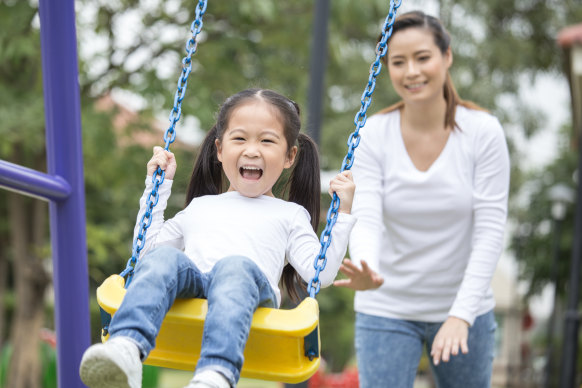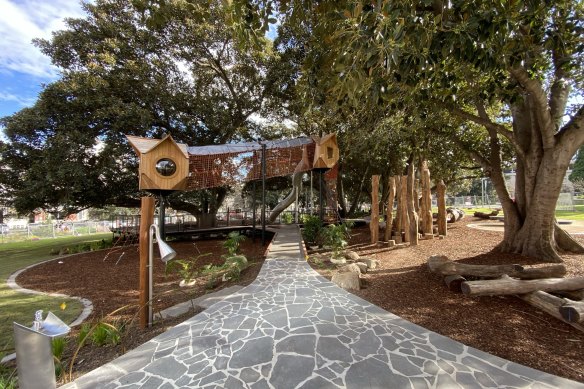Home » World News »
A playground revolution is taking place, but the suburbs are missing out
You might be too old to play in one yourself, but you would have seen them or taken your kids to one: the brightly coloured plastic playgrounds – slide, swing set, monkey bars – that can be found in just about any council park around Australia. Sure, they’re lots of fun, but can we do better for our kids?
In inner Melbourne in the past few years there has been a shift towards nature-based play and away from the cookie-cutter designs of our staple, safety-first playgrounds.
Many playgrounds around Australia look very similar.Credit:Shutterstock
The first of these was the “Nature Play” playground in Royal Park, Parkville. This award-winning design features a “forest climb” ropes course for older kids and a water play area. It opened in 2015 on the site of the former Royal Children’s Hospital Building and was named the nation’s best playground by the Australian Institute of Landscape Architects in 2016. What was perhaps not appreciated at the time is the extent to which this would shape things to come.
More recently, Lincoln Square in Carlton has been revitalised. This site was first used as a playground in 1907, making it Melbourne’s oldest dedicated play space since European settlement. Back then, the play equipment consisted of swings, maypoles and seesaws installed after a resident complained about the lack of facilities to the editor of The Age. There have been many redevelopments of the space since those days, however the most recent reimagining is exceptional.
Nestled under the majestic canopies of 150-year-old Moreton Bay fig trees is a collection of boardwalks, ferns, pods and play areas. There is not a piece of coloured plastic to be seen. Instead, timber and some steel serves as a backdrop to the natural elements. Recycled logs, inscribed with their species and origin, are placed as balance beams, obstacles, and seating. One log has been hollowed out to provide a tunnel for pre-schoolers to climb through.
Fun and nature-inspired infrastructure like this is vital to making our city family-friendly. For too long the perception has been that kids must have a suburban backyard to have a “proper” childhood. But what our urban playgrounds prove is we don’t all need a backyard to provide a space to play. Families do not need to own their own tree house, cubby house or swing set when the community facilities are of this standard.
The revitalised Lincoln Square playground.Credit:Timothy Burgess, City of Melbourne
Spaces like these draw locals from their homes. By actively supporting a diversity of ages and household types within Melbourne, we encourage neighbours to build cross-generational connections, improving our overall resilience and our sense of community.
The Lincoln Square playground also breaks down other perceptions of our city. How often do we hear that our society has become far too protective, or that we have built a nanny state that will not allow kids to be kids. Yet at this playground the risks have not all been designed away. We know that play, including being allowed to take risks, is important for kids’ development. Here there is an understanding that parents and carers can judge for themselves what is suitable for their child, and that in itself encourages active engagement in the child’s play.
The next site for Melbourne City Council’s play space rollout is Bedford Street in North Melbourne, where construction will start early next year. While there are similarities in the design ethos in terms of embracing nature and risk, there is also emphasis on each space having its own identity. Gone are the days when each new playground was a clone of the last. This approach gives the community greater options, but more importantly it shows care. That is exactly what we want from our playgrounds and public spaces – somewhere that has been carefully created, that can make us feel cared for in return.
As great as these new play spaces are, there remains a big equity issue for the kids living in suburbs without high-quality playgrounds. The problem is most acute in more established suburbs where public open space itself is at a premium. Research from PhD candidate Julianna Rozek at RMIT’s Centre for Urban Research has shown that areas such as Collingwood, Caulfield, Southbank and Glen Huntly are particularly challenged for open space on a per capita basis.
Where councils can provide additional space, the land itself becomes a significant expense, putting pressure on the play space to be as cheap as possible. In other councils, a lack of design expertise is contributing to less inspiring outcomes.
As housing density increases and the suburban backyard diminishes in prominence, all councils around Melbourne will need to build many more playgrounds to keep our kids thriving. We should ensure that as councils develop new play spaces, the design and build quality are not afterthoughts. Our kids deserve nothing less.
Most Viewed in National
From our partners
Source: Read Full Article




